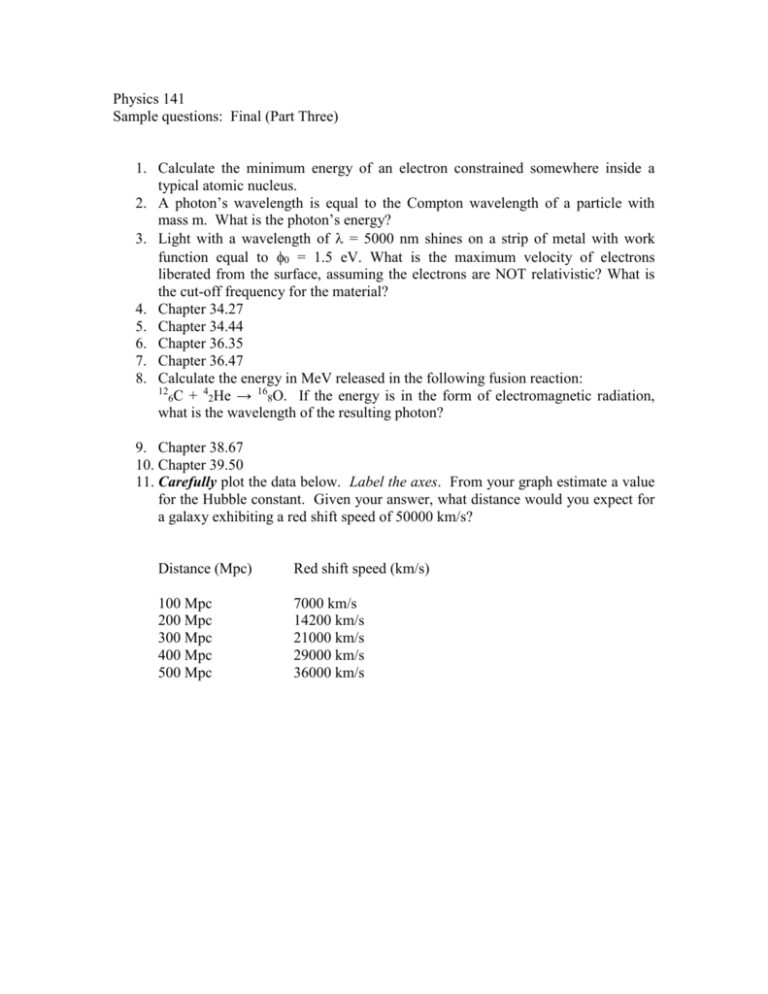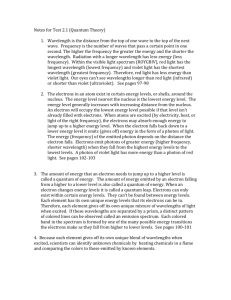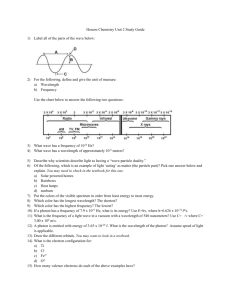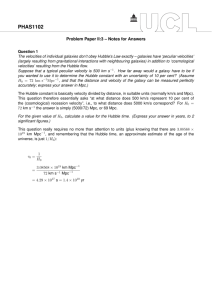Physics 150 - Lawrence University
advertisement

Physics 141 Sample questions: Final (Part Three) 1. Calculate the minimum energy of an electron constrained somewhere inside a typical atomic nucleus. 2. A photon’s wavelength is equal to the Compton wavelength of a particle with mass m. What is the photon’s energy? 3. Light with a wavelength of = 5000 nm shines on a strip of metal with work function equal to 0 = 1.5 eV. What is the maximum velocity of electrons liberated from the surface, assuming the electrons are NOT relativistic? What is the cut-off frequency for the material? 4. Chapter 34.27 5. Chapter 34.44 6. Chapter 36.35 7. Chapter 36.47 8. Calculate the energy in MeV released in the following fusion reaction: 12 4 16 6C + 2He → 8O. If the energy is in the form of electromagnetic radiation, what is the wavelength of the resulting photon? 9. Chapter 38.67 10. Chapter 39.50 11. Carefully plot the data below. Label the axes. From your graph estimate a value for the Hubble constant. Given your answer, what distance would you expect for a galaxy exhibiting a red shift speed of 50000 km/s? Distance (Mpc) Red shift speed (km/s) 100 Mpc 200 Mpc 300 Mpc 400 Mpc 500 Mpc 7000 km/s 14200 km/s 21000 km/s 29000 km/s 36000 km/s 1. A radioactively unstable substance decays such that 3 grams of the decay (daughter) product are found next to 1 gram of the original “parent” isotope. How many half lives have occurred since the original sample was prepared? a. b. c. d. e. 1 2 3 4 None of the above 2. Identify the unknown nuclide in the reaction 168O(n,11H)X. (1 point) a. b. c. d. e. 3. 16 7N 17 9F 15 8O 16 9F 15 7N 22 11Na decays via inverse beta decay. What is the atomic number and proton number of the product? a. b. c. d. e. A = 22, Z = 10 A = 21, Z = 10 A = 23, Z = 12 A = 22, Z = 12 A = 22, Z = 11 4. The wave function for an electron 2 has a value at point A that is greater than at point B. What does this mean for the electron? 1 point) a. b. c. d. 5. The electron won’t appear at point B. The electron will appear at point A. The electron is more likely to appear at A. The electron is more likely to appear at point B. Consider two black bodies: one with a temperature of 12,000 K and another with a temperature of 2,000 K. Compared to the cooler one, the hotter black body a. b. c. d. e. is brighter in the UV, but dimmer in the IR. is brighter in the IR, but dimmer in the UV. is dimmer in both the IR and UV. is brighter in both the IR and UV. None of the above; black bodies do not emit any light. 6. For n = 2, which of the following are the possible values of l, ml, and ms?(1 point) a. b. c. d. e. (l = 1, m1 = -1, ms = ½) (l = 1, m1 = 1, ms = -½) (l = 1, m1 = 0, ms = ½) (l = 0, m1 = 0, ms = ½) All of the above 7. Which of the following are fermions? a. b. c. d. Electrons Photons Neutrinos The Higgs Particle 8. What values of c and h are required for relativistic and quantum effects to be measurable with everyday observations? What other consequences might there be for such a change in the values of these fundamental quantities? 9. How might the Hubble constant change with time if the Universe is decelerating? Accelerating? What would this do to our estimates for the age of the universe? 10. Suppose that stars only reached a mass of 1 solar mass for an upper limit. What consequences would there be for the Universe?











